role play 小学教案
6-牛津版英语四年级升五年级暑期1对1讲义---role play
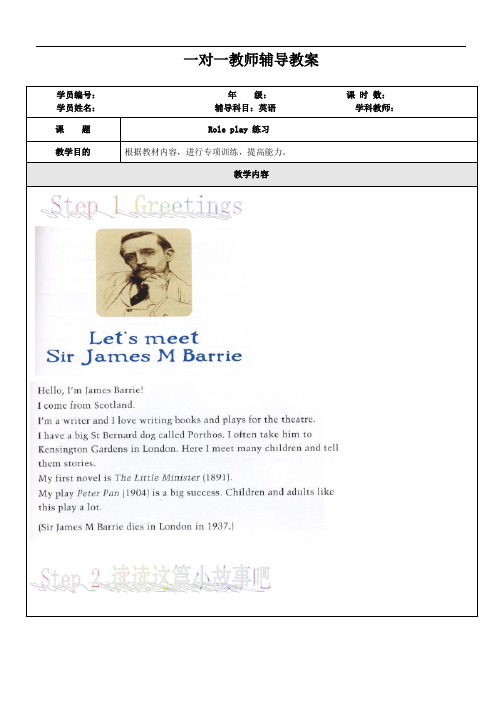
一对一教师辅导教案“南美洲”,类似美国不过是在南方。
我想要住的地方?天堂瀑布。
A land lost in time. I ripped this right out of a library book!rip: 撕library: 图书馆right out of: 从……带走即将消失的土地。
我从图书馆里的书撕下来。
I'm gonna move my club house there! And park it right next to the falls.gonna: <美俚>going to move: 搬park: 置于…我要把房子移到接近瀑布的地方…Who knows what lives up there! And once I get there...天知道还有谁住在上面……一旦我到那里后,I'm gonna save all these pages for all the adventures I'm gonna have.save: 保留page: 页adventure: 冒险我会把冒险的事情接在后面。
Only... I just don't know how I'm gonna get to Paradise Falls. That's it! You can take us there in a blimp! blimp: 小型飞船只是不晓得怎么到那里。
对了你可以用房子当飞船。
Swear you'll take us there! Cross your heart! Cross it! Cross your heart!发誓你会发誓!Good, you promised. No backing out! Well, see you tomorrow, kid. Bye!back out: 食言好!你答应不可以后悔。
英语学校本位课程-角色扮演教学Role-play
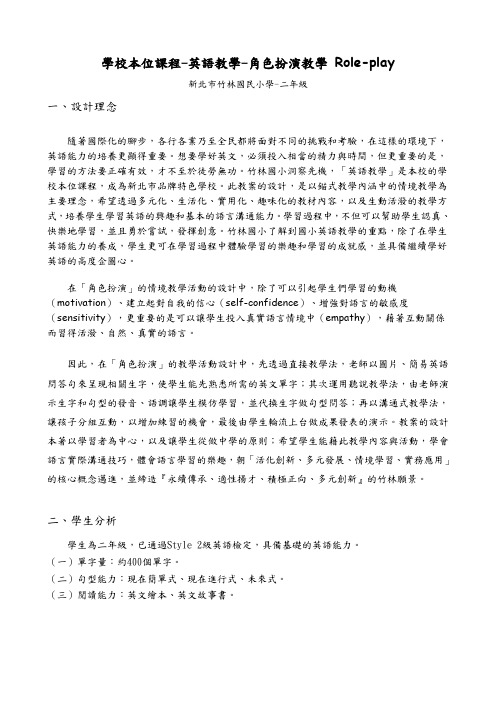
學校本位課程-英語教學-角色扮演教學Role-play新北市竹林國民小學-二年級一、設計理念隨著國際化的腳步,各行各業乃至全民都將面對不同的挑戰和考驗,在這樣的環境下,英語能力的培養更顯得重要。
想要學好英文,必須投入相當的精力與時間,但更重要的是,學習的方法要正確有效,才不至於徒勞無功。
竹林國小洞察先機,「英語教學」是本校的學校本位課程,成為新北市品牌特色學校。
此教案的設計,是以錨式教學內涵中的情境教學為主要理念,希望透過多元化、生活化、實用化、趣味化的教材內容,以及生動活潑的教學方式,培養學生學習英語的興趣和基本的語言溝通能力。
學習過程中,不但可以幫助學生認真、快樂地學習,並且勇於嘗試,發揮創意。
竹林國小了解到國小英語教學的重點,除了在學生英語能力的養成,學生更可在學習過程中體驗學習的樂趣和學習的成就感,並具備繼續學好英語的高度企圖心。
在「角色扮演」的情境教學活動的設計中,除了可以引起學生們學習的動機(motivation)、建立起對自我的信心(self-confidence)、增強對語言的敏感度(sensitivity),更重要的是可以讓學生投入真實語言情境中(empathy),藉著互動關係而習得活潑、自然、真實的語言。
因此,在「角色扮演」的教學活動設計中,先透過直接教學法,老師以圖片、簡易英語問答句來呈現相關生字,使學生能先熟悉所需的英文單字;其次運用聽說教學法,由老師演示生字和句型的發音、語調讓學生模仿學習,並代換生字做句型問答;再以溝通式教學法,讓孩子分組互動,以增加練習的機會,最後由學生輪流上台做成果發表的演示。
教案的設計本著以學習者為中心,以及讓學生從做中學的原則;希望學生能藉此教學內容與活動,學會語言實際溝通技巧,體會語言學習的樂趣,朝「活化創新、多元發展、情境學習、實務應用」的核心概念邁進,並締造『永續傳承、適性揚才、積極正向、多元創新』的竹林願景。
二、學生分析學生為二年級,已通過Style 2級英語檢定,具備基礎的英語能力。
人教版小学英语五年级上册Unit 3 A Let’s learn Role-play教案
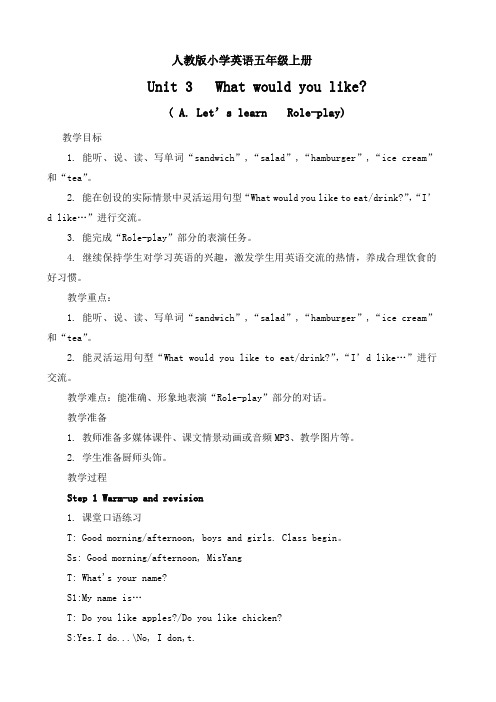
人教版小学英语五年级上册Unit 3 What would you like?( A. Let’s learn Role-play)教学目标1. 能听、说、读、写单词“sandwich”,“salad”,“hamburger”,“ice cream”和“tea”。
2. 能在创设的实际情景中灵活运用句型“What would you like to eat/drink?”,“I’d like…”进行交流。
3. 能完成“Role-play”部分的表演任务。
4. 继续保持学生对学习英语的兴趣,激发学生用英语交流的热情,养成合理饮食的好习惯。
教学重点:1. 能听、说、读、写单词“sandwich”,“salad”,“hamburger”,“ice cream”和“tea”。
2. 能灵活运用句型“What would you like to eat/drink?”,“I’d like…”进行交流。
教学难点:能准确、形象地表演“Role-play”部分的对话。
教学准备1. 教师准备多媒体课件、课文情景动画或音频MP3、教学图片等。
2. 学生准备厨师头饰。
教学过程Step 1 Warm-up and revision1. 课堂口语练习T: Good morning/afternoon, boys and girls. Class begin。
Ss: Good morning/afternoon, MisYangT: What's your name?S1:My name i s…T: Do you like apples?/Do you like chicken?S:Yes.I do...\No, I don,t.2. 教师用多媒体课件出示视频,一起听一首关于食物的歌,复习已经学过的食物来引出课题。
3.呈现歌曲中听到的菜品,问学生认识它们么,并用英语回答出来。
T: Do you know them?SI: Yes, potatoes.S2: fishS3: noodlesT:You can answer like this: "I’dlike potatoes".Ss repeatT: What would you like to eat?S2: I'd like… please设计意图学生通过复习旧知识自然引出课题,下面的教学自然就水到渠成。
典型教案roleplay
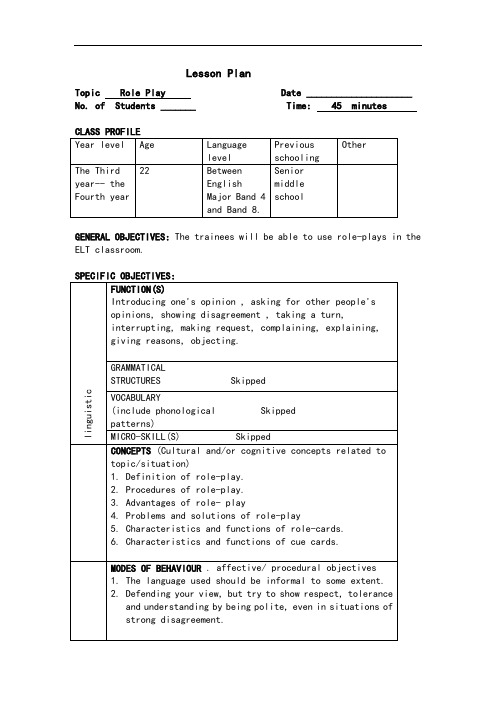
Lesson PlanTopic Role Play Date _____________________ No. of Students _______ Time: 45 minutesGENERAL OBJECTIVES: The trainees will be able to use role-plays in the ELT classroom.RATIONALE . why select these linguistic/conceptual objectives) LINGUISTIC:Role-play is an active phase of learning, so it involves a number of language functions. Students should pay attention to use right language form to express those functions.CONCEPTUAL/CULTURAL:The conversation goes on in a break, so the language used should be informal to some extent. Since the conversation takes place in a staffroom between colleagues, the speakers should keep polite manner.ASSUMED KNOWLEDGE . what do you assume learners know/can do ) LINGUISTIC:All trainees are familiar with the vocabulary and grammatical rules related to the topic, so it is unnecessary to present those language elements.CONCEPTUAL/CULTURAL:Most of the trainees have the experiences of role-play, but they are not theoretically clear about the definition, procedures, advantages, problems and solutions of role-plays. It is difficult for them to show respect, tolerance by being polite in situations of strong disagreement.AIDS: Overhead projector, computer, lesson plan in PPT.PROCEDUREPre-task activitiesactivity (1minut )of four groups (each member in a group getting the samerole-card)( 2minuts )the situation of the main task.(3minutes)Situation: You are four teachers meeting in the staffroom. You are very different with regard to your age, character and teaching experience. Try to speak to your colleagues in this role play as you would speak to colleagues in the staffroom, who are not necessarily your friends, whose viewpoints you might not agree with. Keep to polite language and social conventions.4. Helping students deal with necessary vocabulary, functions and register.( 2minutes)5. Carrying on group work to prepare arguments for this role together. ( 10minutes)Do not look at the other groups' role cards. Try to feel for your character, even if she/he is someone you probably wouldn't particularly like.While-task activities1. Second grouping. (1minut )Groups of four (each person having a different role now)2. Role-playing. (15 minutes)Post-task activitiesthe loop input of role play, mapping the content and the procedure in pairs. (4 minutes)2. Discussing on the aspects of role play. (4 minutes)3. Feedback and delayed error correction of language aspects. (3 minutes)ANTICIPATED PROBLEMS AND SOLUTIONSProblem :They create chaos in the classroomSolution: Careful consideration of classroom management necessary, the students have to be prepared gradually for this less formal type of of classroom activity (pair work first, short role plays first)Problem :They are inhibiting: some student are too shy to actSolution:They don't have to perform, just play a part; emphasis on 'play' rather than 'role'; careful preparationProblem : The students don't know what to saySolution:They need help with ideas and language: warm-ups, preparation, role-cards; they have to be prepared for the concept of their roles graduallyProblem : The students don't really learn anythingSolution: Analysis and evaluation of the language used is necessary. Practice of language they know in a free and uncontrolled way is important. Role-play = active phase of learning.Problem :The students find it difficult to pretend to be someone else.Solution: Careful preparation; student-generated role cards.Problem : They are too unpredictable.Solution: Tell students that unpredictability is present in daily life. Role plays can help to avoid the shock of language students in real life situations.Problem : they take too much time to prepareSolution: the teacher can take many ideas in coursebooks, in resources books; in student-generated role- plays. Preparation itself can be language practice already.Problem : The teacher cannot hear everyoneSolution:The students are distracted in full class form, too; the teacher cannot correct more than one student in full class form either; delayed correction as one possibility.MATERIALS:Role cardsRole card 1You are a teacher. You have been teaching at your school for about 20 years now. You are used to traditional teaching methods, and you have never tried role-plays in your classes.You had a tiring morning; the students in some of your classes were particularly undisciplined today. You meet three colleagues in the staffroom. You have, unusually, time to talk. These colleagues are not your friends, but you respect them as being good teachers.One of these colleagues starts a discussion on using role-plays in class. You want to convince the others that role-plays are not useful in class. You might admit one or two positive aspects that role-plays could have in the learning process, but generally you are strongly opposed to all'these new teaching methods' that take a lot of energy and preparation time.Role card 2You are a trainee teacher and an absolute beginner in the field of teaching English. You are anxious to cope with the amount of coursebook units and not to lose control over your students.You had a stressful time this morning, because one of your teacher trainers observed your lesson. You meet three colleagues in the staffroom. You have, unusually, time to talk. These colleagues are not your friends, but you respect them as being good teachers.One of these colleagues starts a discussion on using role-plays in class. You support one teacher's view that role-plays are not useful in class. Not long ago your teacher trainer asked you to try a role-play with one of your classes, which, however, turned out to be a disaster. You suddenly remember all the negative aspects and you cannot imagine ever using role-plays in your classes again; you much rather stick to other exercises the coursebook offers to you.Role card 3You are a teacher. You have been teaching English for a short time only, and you like trying new ideas.You have just used a role-play in one of your classes and feel it was very successful. You meet three colleagues in the staffroom. You have, unusually, time to talk. These colleagues are not your friends, but you respect them as being good teachers.You start a discussion on using role-plays in class telling your colleagues about the role-play you have just asked your students to do. You want to convince the others that role-plays are very useful in class. While admitting one or two problems that role-plays can bring about you are absolutely convinced that students learn a lot that way and you feel very confident and enthusiastic because of the experience you have just made.Role card 4You are a teacher. You have been teaching English for a couple of years already. You have just come back with lots of enthusiasm from two exciting weeks of teacher training in England.You had an interesting morning, because you tried some new ideas from the teacher training course. You meet three colleagues in the staffroom. You have, unusually, time to talk. These colleagues are not your friends, but you respect them as being good teachers.One of these colleagues starts a discussion on using role-plays in class. With missionary zeal you want to convince the others to usestudent-oriented speaking exercises on fluency such as role-plays much more often.Definition of role-playRole-play is an activity in which students imagine a role and have unscripted dialogues or discussion in a given situation..Advantages of the role-playIt is a rehearsal for real life situations in a friendly and safe environmentwith a wide variety of experience and situations brought into the classroom.Students explore language as it works in the real worldLanguage used is unpredictable as in daily life., no longer limited to the kind of language used by learners in the classroom.Acting out a situation encourages the students to use natural expressions and intonations as well as gestures.It is a kind of teaching of social skills.It increases motivation.It develops creativity.It promotes interaction.It encourages peer learning.'learning by doing' is an extremely effective way of learningSome students are liberatedStudents might find it easier to express themselves behind the mask of being someone else, communicate more freely if they have a role to hide behind. They no longer feel that their own personality is implicatedCharacteristics and functions of role-cardsGiving necessary background information: situation/context; persons: name, age, job/social status ,personality, feelings/aims/beliefs .Explaining the relationship to other people involved in the role-playGiving objectives, indicating possible behavior and actionsEncouraging spontaneous interaction by 'information-gaps'Helping with language: vocabulary, functions and register.Students' cognitive, linguistic and emotional preparation for free role playsCharacteristics and functions of cue-cardsNaming of situation and people involvedGiving explicit instruction to what should be said about content and language.Encouraging spontaneous interaction by 'information-gaps'Considering different levels and linguistic skills.Offering visual clues and verbal clues.Offering a variety of suggested answers to choose from.Allowing students' own phrasingIntroducing different registersIntroducing different functionReduction of errorsDirected practice of specific speaking skillsBuilding confidence in using the English languageIntroducing students to free discourseIntroducing students to pair/group work and student-oriented learningPossibility of varying level of difficultyRole cards 1-4:Since you have this talk in a break, the language you use can be informal to some extent. Defend your view, but try to show respect, tolerance and understanding by being polite, even in situations of strong disagreement.Here are some language functions you can use: Introducing one's opinion , asking for other people's opinions, showing disagreement , taking a turn, interrupting, making request, complaining, explaining, giving reasons, objecting.CRITERIA FOR EVALUATION. how will you decide objectives have been met)trainees can complete the role-play successfully.2 The trainees can map the content and the procedure in pairs and realize the advantage of the loop-input.3. The trainees can summarize the aspects of role play.4. The trainees are able to use informal language and speak in a polite manner.ACTUAL EVALUATION. to what extent were objectives met/what could you have done to improve effectiveness of lesson)The trainees have completed the role-play successfully, mapped the content and the procedure in pairs and realized the advantage of the loop-input. They can use informal language and speak in a polite manner. But they feel difficult to retell all aspects of the role play. The time for post-task activities should be longer. a polite manner.。
人教PEP版英语五年级上册Unit 3教案第2课时
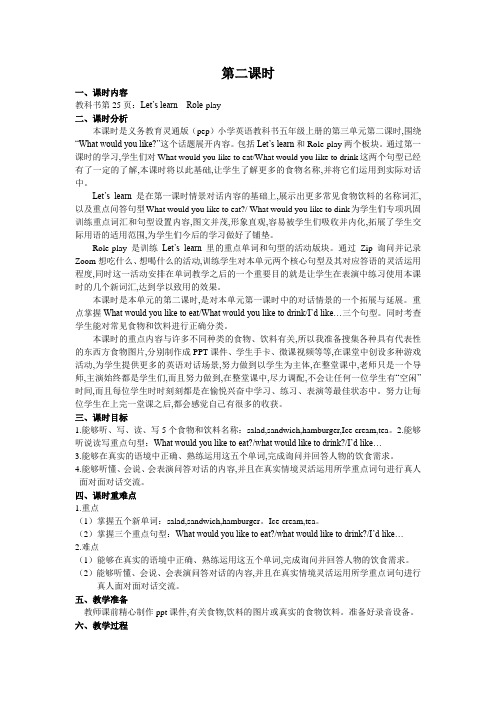
第二课时一、课时内容教科书第25页:Let’s learn Role-play二、课时分析本课时是义务教育灵通版(pep)小学英语教科书五年级上册的第三单元第二课时,围绕“What would you like?”这个话题展开内容。
包括Let’s learn和Role-play两个板块。
通过第一课时的学习,学生们对What would you like to eat/What would you like to drink这两个句型已经有了一定的了解,本课时将以此基础,让学生了解更多的食物名称,并将它们运用到实际对话中。
Let’s learn是在第一课时情景对话内容的基础上,展示出更多常见食物饮料的名称词汇,以及重点问答句型What would you like to eat?/ What would you like to dink为学生们专项巩固训练重点词汇和句型设置内容,图文并茂,形象直观,容易被学生们吸收并内化,拓展了学生交际用语的适用范围,为学生们今后的学习做好了铺垫。
Role-play是训练Let’s learn里的重点单词和句型的活动版块。
通过Zip 询问并记录Zoom想吃什么、想喝什么的活动,训练学生对本单元两个核心句型及其对应答语的灵活运用程度,同时这一活动安排在单词教学之后的一个重要目的就是让学生在表演中练习使用本课时的几个新词汇,达到学以致用的效果。
本课时是本单元的第二课时,是对本单元第一课时中的对话情景的一个拓展与延展。
重点掌握What would you like to eat/What would you like to drink/I’d like…三个句型。
同时考查学生能对常见食物和饮料进行正确分类。
本课时的重点内容与许多不同种类的食物、饮料有关,所以我准备搜集各种具有代表性的东西方食物图片,分别制作成PPT课件、学生手卡、微课视频等等,在课堂中创设多种游戏活动,为学生提供更多的英语对话场景,努力做到以学生为主体,在整堂课中,老师只是一个导师,主演始终都是学生们,而且努力做到,在整堂课中,尽力调配,不会让任何一位学生有“空闲”时间,而且每位学生时时刻刻都是在愉悦兴奋中学习、练习、表演等最佳状态中。
五年级英语上册Unit3课时2Let'slearn_Role_play教案人教PEP(含教学反思)
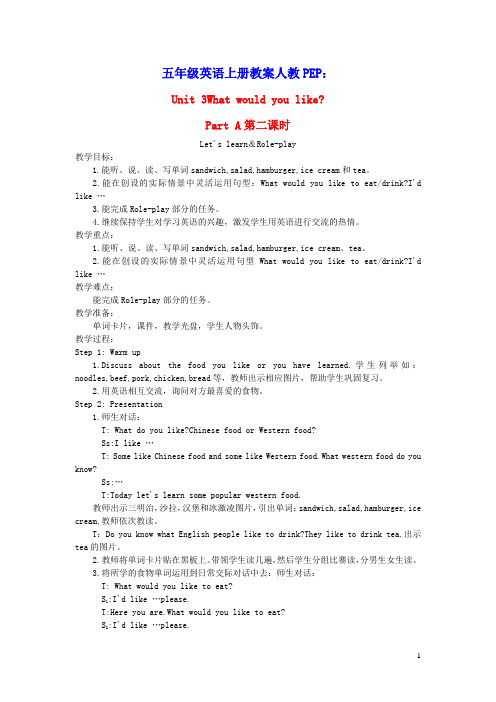
五年级英语上册教案人教PEP:Unit 3What would you like?Part A第二课时Let's learn&Role-play教学目标:1.能听、说、读、写单词sandwich,salad,hamburger,ice cream和tea。
2.能在创设的实际情景中灵活运用句型:What would you like to eat/drink?I'd like …3.能完成Role-play部分的任务。
4.继续保持学生对学习英语的兴趣,激发学生用英语进行交流的热情。
教学重点:1.能听、说、读、写单词sandwich,salad,hamburger,ice cream、tea。
2.能在创设的实际情景中灵活运用句型What would you like to eat/drink?I'd like …教学难点:能完成Role-play部分的任务。
教学准备:单词卡片,课件,教学光盘,学生人物头饰。
教学过程:Step 1: Warm up1.Discuss about the food you like or you have learned.学生列举如:noodles,beef,pork,chicken,bread等,教师出示相应图片,帮助学生巩固复习。
2.用英语相互交流,询问对方最喜爱的食物。
Step 2: Presentation1.师生对话:T: What do you like?Chinese food or Western food?Ss:I like …T: Some like Chinese food and some like Western food.What western food do you know?Ss:…T:Today let's learn some popular western food.教师出示三明治,沙拉,汉堡和冰激凌图片,引出单词:sandwich,salad,hamburger,ice cream,教师依次教读。
外研英语六年级上优质教案:Module5 Unit 2 I can speak French 教案
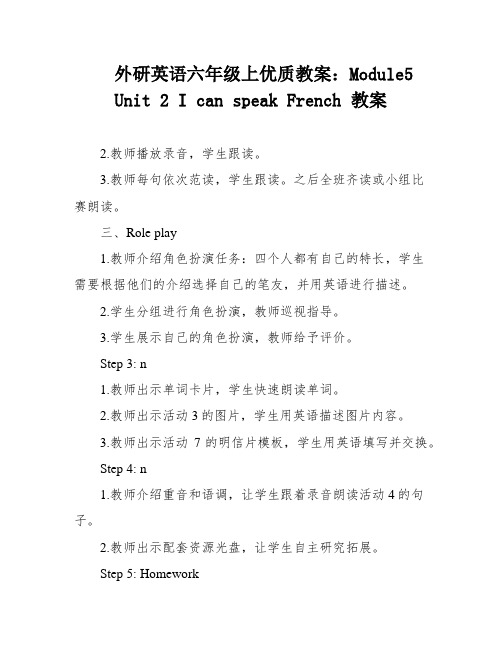
外研英语六年级上优质教案:Module5Unit 2 I can speak French 教案2.教师播放录音,学生跟读。
3.教师每句依次范读,学生跟读。
之后全班齐读或小组比赛朗读。
三、Role play1.教师介绍角色扮演任务:四个人都有自己的特长,学生需要根据他们的介绍选择自己的笔友,并用英语进行描述。
2.学生分组进行角色扮演,教师巡视指导。
3.学生展示自己的角色扮演,教师给予评价。
Step 3: n1.教师出示单词卡片,学生快速朗读单词。
2.教师出示活动3的图片,学生用英语描述图片内容。
3.教师出示活动7的明信片模板,学生用英语填写并交换。
Step 4: n1.教师介绍重音和语调,让学生跟着录音朗读活动4的句子。
2.教师出示配套资源光盘,让学生自主研究拓展。
Step 5: Homework1.完成配套资源光盘上的练。
2.准备下节课的自我介绍。
In this lesson。
students will learn about pen pals and how to XXX will present Mike's postcard and introduce him in English。
Mike is 11 years old and from Sydney。
XXX。
reading。
swimming。
and singing songs。
The same method will be used to introduce Tingting。
Jim。
and Linda.The lesson will focus on the use of "can" and "like" in sentences。
"Can" is a modal verb that does not change with the subject and is followed by the base form of the verb。
典型教案设计role play
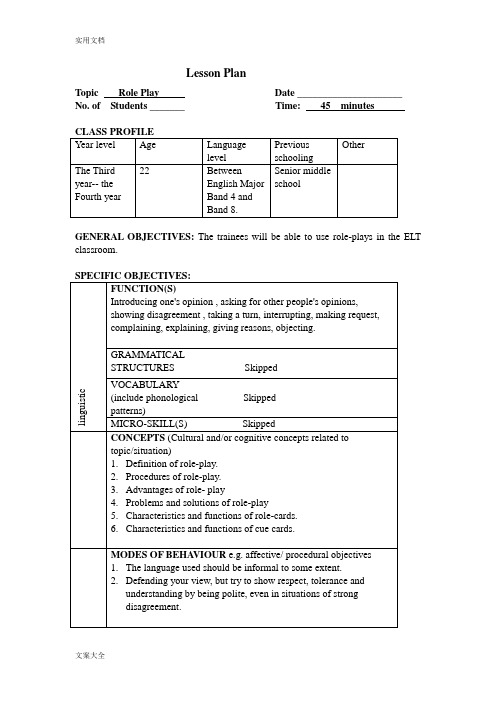
Lesson PlanTopic Role Play Date _____________________ No. of Students _______ Time: 45 minutesGENERAL OBJECTIVES:The trainees will be able to use role-plays in the ELT classroom.RATIONALE (i.e. why select these linguistic/conceptual objectives?) LINGUISTIC:Role-play is an active phase of learning, so it involves a number of language functions. Students should pay attention to use right language form to express those functions.CONCEPTUAL/CULTURAL:The conversation goes on in a break, so the language used should be informal to some extent. Since the conversation takes place in a staffroom between colleagues, the speakers should keep polite manner.ASSUMED KNOWLEDGE (i.e. what do you assume learners know/can do ?) LINGUISTIC:All trainees are familiar with the vocabulary and grammatical rules related to the topic, so it is unnecessary to present those language elements.CONCEPTUAL/CULTURAL:Most of the trainees have the experiences of role-play, but they are not theoretically clear about the definition, procedures, advantages, problems and solutions ofrole-plays. It is difficult for them to show respect, tolerance by being polite in situations of strong disagreement.AIDS: Overhead projector, computer, lesson plan in PPT.PROCEDUREPre-task activities1.Warming-up activity (1minut )2.Forming of four groups (each member in a group getting the samerole-card)( 2minuts )3.Explaining the situation of the main task.(3minutes)Situation: You are four teachers meeting in the staffroom. You are very different with regard to your age, character and teaching experience.Try to speak to your colleagues in this role play as you would speak to colleagues in the staffroom, who are not necessarily your friends, whose viewpoints you might not agree with. Keep to polite language and social conventions.4. Helping students deal with necessary vocabulary, functions and register.( 2minutes)5. Carrying on group work to prepare arguments for this role together. ( 10minutes) Do not look at the other groups' role cards. Try to feel for your character, even ifshe/he is someone you probably wouldn't particularly like.While-task activities1. Second grouping. (1minut )Groups of four (each person having a different role now)2. Role-playing. (15 minutes)Post-task activities1.Evaluating the loop input of role play, mapping the content and the procedure in pairs. (4 minutes)2. Discussing on the aspects of role play. (4 minutes)3. Feedback and delayed error correction of language aspects. (3 minutes) ANTICIPATED PROBLEMS AND SOLUTIONSProblem :They create chaos in the classroomSolution: Careful consideration of classroom management necessary, the students have to be prepared gradually for this less formal type of of classroom activity (pair work first, short role plays first)Problem :They are inhibiting: some student are too shy to actSolution: They don't have to perform, just play a part; emphasis on 'play' rather than 'role'; careful preparationProblem : The students don't know what to saySolution: They need help with ideas and language: warm-ups, preparation, role-cards; they have to be prepared for the concept of their roles graduallyProblem : The students don't really learn anythingSolution: Analysis and evaluation of the language used is necessary. Practice of language they know in a free and uncontrolled way is important. Role-play = active phase of learning.Problem :The students find it difficult to pretend to be someone else.Solution: Careful preparation; student-generated role cards.Problem : They are too unpredictable.Solution: Tell students that unpredictability is present in daily life. Role plays can help to avoid the shock of language students in real life situations.Problem : they take too much time to prepareSolution: the teacher can take many ideas in coursebooks, in resources books; in student-generated role- plays. Preparation itself can be language practice already.Problem : The teacher cannot hear everyoneSolution:The students are distracted in full class form, too; the teacher cannot correct more than one student in full class form either; delayed correction as one possibility.MATERIALS:Role cardsRole card 1You are a teacher. You have been teaching at your school for about 20 years now. You are used to traditional teaching methods, and you have never tried role-plays in your classes.You had a tiring morning; the students in some of your classes were particularly undisciplined today. You meet three colleagues in the staffroom. You have, unusually, time to talk. These colleagues are not your friends, but you respect them as being good teachers.One of these colleagues starts a discussion on using role-plays in class. You want to convince the others that role-plays are not useful in class. You might admit one or two positive aspects that role-plays could have in the learning process, but generally you are strongly opposed to all 'these new teaching methods' that take a lot of energy and preparation time.Role card 2You are a trainee teacher and an absolute beginner in the field of teaching English. You are anxious to cope with the amount of coursebook units and not to lose control over your students.You had a stressful time this morning, because one of your teacher trainers observed your lesson. You meet three colleagues in the staffroom. You have, unusually, time to talk. These colleagues are not your friends, but you respect them as being good teachers.One of these colleagues starts a discussion on using role-plays in class. You support one teacher's view that role-plays are not useful in class. Not long ago your teacher trainer asked you to try a role-play with one of your classes, which, however, turned out to be a disaster. You suddenly remember all the negative aspects and you cannot imagine ever using role-plays in your classes again; you much rather stick to other exercises the coursebook offers to you.Role card 3You are a teacher. You have been teaching English for a short time only, and you like trying new ideas.You have just used a role-play in one of your classes and feel it was very successful. You meet three colleagues in the staffroom. You have, unusually, time to talk. These colleagues are not your friends, but you respect them as being good teachers.You start a discussion on using role-plays in class telling your colleagues about the role-play you have just asked your students to do. You want to convince the others that role-plays are very useful in class. While admitting one or two problems that role-plays can bring about you are absolutely convinced that students learn a lot that way and you feel very confident and enthusiastic because of the experience you have just made.Role card 4You are a teacher. You have been teaching English for a couple of years already. You have just come back with lots of enthusiasm from two exciting weeks of teacher training in England.You had an interesting morning, because you tried some new ideas from the teacher training course. You meet three colleagues in the staffroom. You have, unusually, time to talk. These colleagues are not your friends, but you respect them as being good teachers.One of these colleagues starts a discussion on using role-plays in class. With missionary zeal you want to convince the others to use student-oriented speaking exercises on fluency such as role-plays much more often.Definition of role-playRole-play is an activity in which students imagine a role and have unscripted dialogues or discussion in a given situation..Advantages of the role-playIt is a rehearsal for real life situations in a friendly and safe environmentwith a wide variety of experience and situations brought into the classroom. Students explore language as it works in the real worldLanguage used is unpredictable as in daily life., no longer limited to the kind of language used by learners in the classroom.Acting out a situation encourages the students to use natural expressions and intonations as well as gestures.It is a kind of teaching of social skills.It increases motivation.It develops creativity.It promotes interaction.It encourages peer learning.'learning by doing' is an extremely effective way of learningSome students are liberatedStudents might find it easier to express themselves behind the mask of being someone else, communicate more freely if they have a role to hide behind. They no longer feel that their own personality is implicatedCharacteristics and functions of role-cardsGiving necessary background information:situation/context; persons: name, age, job/social status ,personality, feelings/aims/beliefs .Explaining the relationship to other people involved in the role-playGiving objectives, indicating possible behavior and actionsEncouraging spontaneous interaction by 'information-gaps'Helping with language: vocabulary, functions and register.Students' cognitive, linguistic and emotional preparation for free role plays Characteristics and functions of cue-cardsNaming of situation and people involvedGiving explicit instruction to what should be said about content and language. Encouraging spontaneous interaction by 'information-gaps'Considering different levels and linguistic skills.Offering visual clues and verbal clues.Offering a variety of suggested answers to choose from.Allowing students' own phrasingIntroducing different registersIntroducing different functionReduction of errorsDirected practice of specific speaking skillsBuilding confidence in using the English languageIntroducing students to free discourseIntroducing students to pair/group work and student-oriented learningPossibility of varying level of difficultyRole cards 1-4:Since you have this talk in a break, the language you use can be informal to some extent. Defend your view, but try to show respect, tolerance and understanding by being polite, even in situations of strong disagreement.Here are some language functions you can use: Introducing one's opinion , asking for other people's opinions, showing disagreement , taking a turn, interrupting, making request, complaining, explaining, giving reasons, objecting.CRITERIA FOR EV ALUATION(i.e. how will you decide objectives have been met?)1.The trainees can complete the role-play successfully.2 The trainees can map the content and the procedure in pairs and realize the advantage of the loop-input.3. The trainees can summarize the aspects of role play.4. The trainees are able to use informal language and speak in a polite manner.ACTUAL EV ALUATION(i.e. to what extent were objectives met/what could you have done to improve effectiveness of lesson?)The trainees have completed the role-play successfully, mapped the content and the procedure in pairs and realized the advantage of the loop-input. They can use informal language and speak in a polite manner. But they feel difficult to retell all aspects of the role play. The time for post-task activities should be longer. a polite manner.。
人教版PEP六年级英语上册教案:Unit 2 Ways to go to school(第四课时)

The fourth period(第四课时)Part B Let’s learn & Role-play▶教学内容与目标课时教学内容课时教学目标Let’s learn·能够按照正确的意群及语音、语调朗读对话,并能够在小组中进行角色表演·能够听、说、读、写单词及词组:stop, wait, slow down, go·能够熟练运用句型“…must…”提出建议Role-play·能够根据自己的角色(Mike、盲人和红绿灯演示者)用英语进行交流·能够了解一些简单的交通标志和交通规则,增强学生的交通意识▶教学重点1.能够了解基本的交通规则,即红、黄、绿灯的功能,并能根据英文指令做动作。
2.能够理解和掌握本课重点词汇和句型。
▶教学难点1.理解动词stop和wait的含义。
2.能够在情景中恰当运用句子“Slow down and stop at a yellow light. Stop and wait at a red light. Go at a green light.”表达交通指示灯的作用。
▶教学准备1.预习本课时的相关内容。
2.PPT课件、课文录音、视频、卡片、模拟红绿灯等。
▶教学过程Step 1: Warm-up & Revision & Lead-in1. Greetings.2. Let’s sing and do.Play the song—Rabbit Dance. (出示课件)Let students stand ina line and do the actions with the music.“Left—left—right—right—go—turn around—go—go—go!”3.Lead-in.(1)Review the traffic rules.Show the pictures. (课件出示:上节课学过的交通规则图片) Letstudents look and say.(2)Lead-in.T:(课件出示:交通信号灯图片) What are these?Ss:Traffic lights.T:Yeah. They are the traffic lights. What colour are they?Teaching purpose音乐节奏轻松愉悦,能够激发学生的兴趣。
英语五年级上册(PEP)Part A Let's learn Role-play教案
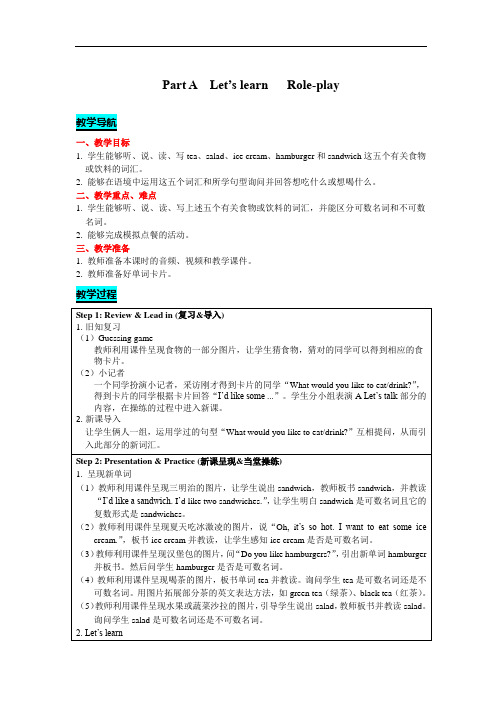
Part A Let’s learn Role-play一、教学目标1. 学生能够听、说、读、写tea、salad、ice cream、hamburger和sandwich这五个有关食物或饮料的词汇。
2. 能够在语境中运用这五个词汇和所学句型询问并回答想吃什么或想喝什么。
二、教学重点、难点1. 学生能够听、说、读、写上述五个有关食物或饮料的词汇,并能区分可数名词和不可数名词。
2. 能够完成模拟点餐的活动。
三、教学准备1. 教师准备本课时的音频、视频和教学课件。
2. 教师准备好单词卡片。
(1)教师播放Let’s learn部分的动画,让学生听录音跟读,并及时纠正发音问题。
(2)教师拿着这五种食物或饮料的单词卡片,和学生进行对话。
T: What would you like to eat/drink?S: I’d like ...T: Here you are. (将相应的单词卡片递给学生)S: Thank you.(3)仿编对话刚才拿了单词卡片的同学轮流到讲台上,根据手上的卡片进行问答练习。
示例如下:Ss: What would you like to eat/drink?S1/2/3/4/5: I’d like ...3. Role-play(1)教师先请两名学生做示范朗读对话。
(2)学生俩人一组完成菜单,一人扮演客人,一人扮演服务员,模仿示例表演对话。
(3)请几组学生上讲台表演,并评选出“最佳表演者”。
Step 3: Consolidation & Extension (巩固&拓展)1. 游戏:贴一贴教师在黑板两边分别写上“What would you like to eat?”“What would you like to drink?”,学生根据自己手中的单词卡片的种类贴到相应的句子下面,并用“I’d like…”句型表达出来。
2. 活动:句子接龙每组的第一名学生问第二名学生“What would you like to eat?”,第二名学生回答“I’d like …”,并问第三名学生“What do you like to drink?”,以此类推。
人教版六年级英语上册PEP教案第三单元My weekend plan第四课时

人教版六年级英语上册PEP教案第三单元My weekend plan第四课时一、教学内容Part B Let's learn & Role-play二、教学目标1.能听、读、表演本节课的对话和课文。
2.能运用简单的句型讨论交流有关购物的话题。
3.使学生在学习中乐于交流,敢于表达,养成热心帮助他人的良好品质。
三、教学重难点1.能够听、说、读、写:comic book、dictionary、postcard、word book。
2.能运用简单的句型讨论交流有关购物的话题。
四、教学准备多媒体课件、单词图片。
五、教学过程Step 1 Warming-up1.Free talk教师借助图片及多媒体,向学生展示一些基本的学习用具,让学生加以复习,如bag、eraser、ruler、book等单词,引出本节课的主题。
2.Chant带领学生练习简单的歌谣,让学生熟悉本课所涉及文具的名称,训练学生的发音和语感。
Ruler,ruler,do you want rulers?Book,book,do you want books?Pencil,pencil,do you want pencils?School things,school things,I want them all.3.Ask and answerShow students the pictures and talk about them.—What's this in English?—It's a(n)…Step 2 Presentation1.学习Let's learn(1)从文具的话题中引出本节课的生词,展示四幅图片加以讨论dictionary、comic book、word book、postcard。
—What's this in English?—It's a(n)…(2)教师板书新单词和新短语,让学生根据图片尝试说出单词和短语及其汉语意思。
六年级英语上册Unit2Waystogotoschool(第三课时Blet’slearnRoleplay)教案设计人教PEP
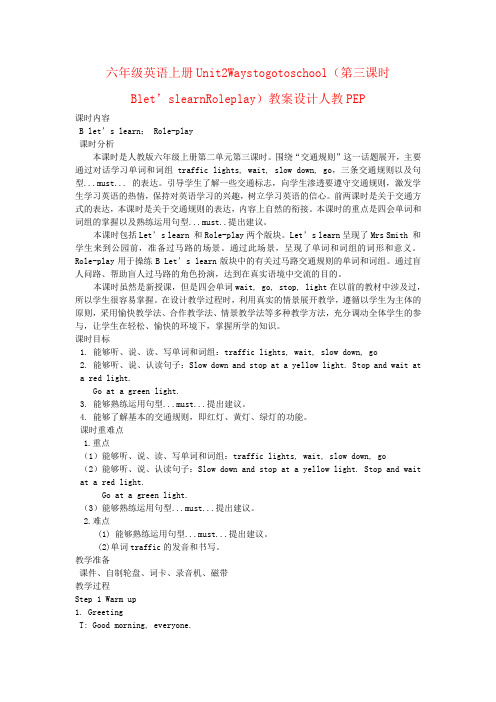
六年级英语上册Unit2Waystogotoschool(第三课时Blet’slearnRoleplay)教案设计人教PEP课时内容B let’s learn; Role-play课时分析本课时是人教版六年级上册第二单元第三课时。
围绕“交通规则”这一话题展开,主要通过对话学习单词和词组traffic lights, wait, slow down, go,三条交通规则以及句型...must... 的表达。
引导学生了解一些交通标志,向学生渗透要遵守交通规则,激发学生学习英语的热情,保持对英语学习的兴趣,树立学习英语的信心。
前两课时是关于交通方式的表达,本课时是关于交通规则的表达,内容上自然的衔接。
本课时的重点是四会单词和词组的掌握以及熟练运用句型...must..提出建议。
本课时包括Let’s learn 和Role-play两个版块。
Let’s learn呈现了Mrs Smith 和学生来到公园前,准备过马路的场景。
通过此场景,呈现了单词和词组的词形和意义。
Role-play用于操练B Let’s learn版块中的有关过马路交通规则的单词和词组。
通过盲人问路、帮助盲人过马路的角色扮演,达到在真实语境中交流的目的。
本课时虽然是新授课,但是四会单词wait, go, stop, light在以前的教材中涉及过,所以学生很容易掌握。
在设计教学过程时,利用真实的情景展开教学,遵循以学生为主体的原则,采用愉快教学法、合作教学法、情景教学法等多种教学方法,充分调动全体学生的参与,让学生在轻松、愉快的环境下,掌握所学的知识。
课时目标1. 能够听、说、读、写单词和词组:traffic lights, wait, slow down, go2. 能够听、说、认读句子:Slow down and stop at a yellow light. Stop and wait ata red light.Go at a green light.3. 能够熟练运用句型...must...提出建议。
人教PEP版英语五年级下册 Unit 1教案第一课时

第一课时一、课时内容教科书第4页:A. Let’s try Let’s talk Role-play二、课时分析本课时是义务教育灵通版(PEP)小学英语教科书五年级下册的第一单元第一课时,围绕“询问对方一天中的作息时间”这个话题展开内容。
包括Let’s try,Let’s talk和Role-play三个板块。
Let’s try是听力训练,是为Let’s talk部分做铺垫的。
Let’s talk是围绕本单元的总话题My day展开的第一个对话场景,即张鹏与佩德罗谈论有关西方小学生日常作息时间的对话,呈现了When do you…?的句型,通过张鹏询问佩德罗上午什么时候放学,午饭之后什么时候上学,以及什么时候吃晚饭等一系列问题,可以了解西方国家小学生的作息时间与我们中国的小学生的大不相同,引导学生通过积极地询问,会得到很多意想不到的信息。
Role-play是为专项训练句型When do you…?创作的问答表演活动,用以巩固重点句型的熟练程度。
本课时是整个单元的首课时,在本单元中起引领与铺垫作用,重点掌握when do you…?的问答句型和一些常用动词短语。
对话中呈现了三个句型相同内容不同的问句,加深了学生对该句型的认知度, 接下来又呈现了四幅图,分别代表不同职业的人,学生们通过扮演不同职业的人,运用句型when do you…?进行问答活动,从而了解不同职业的人,起居生活也不同,感悟到工作人员的辛苦与坚韧的高贵品质。
五年级的学生,有着三、四年级的学习英语的经历,具备一定的语言感知能力,因此我准备采用多次呈现对话情景动画,通过声形并茂的方式,感染学生,使学生在新授之前,就可以了解对话内容,再鼓励学生模仿表演对话,感知新句型的应用功能,最后再提炼重点句型,通过游戏活动加以巩固。
三、课时目标1.能听说认读单词“when,after,start,usually,Spain,late”。
2.能听懂、会说、运用句型“When do you finish class in the morning?” “We finish class at 1 o’clock.”3.知道助动词do在问句中的作用与用法。
人教版pep五年级下册英语全册教案教学设计
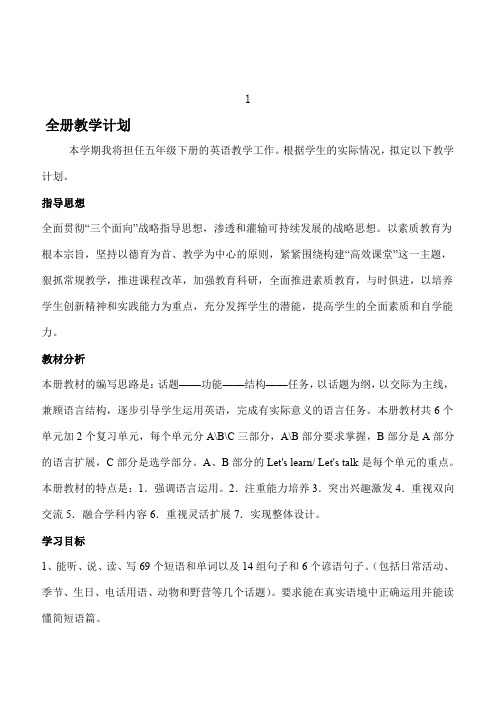
1全册教学计划本学期我将担任五年级下册的英语教学工作。
根据学生的实际情况,拟定以下教学计划。
指导思想全面贯彻“三个面向”战略指导思想,渗透和灌输可持续发展的战略思想。
以素质教育为根本宗旨,坚持以德育为首、教学为中心的原则,紧紧围绕构建“高效课堂”这一主题,狠抓常规教学,推进课程改革,加强教育科研,全面推进素质教育,与时俱进,以培养学生创新精神和实践能力为重点,充分发挥学生的潜能,提高学生的全面素质和自学能力。
教材分析本册教材的编写思路是:话题——功能——结构——任务,以话题为纲,以交际为主线,兼顾语言结构,逐步引导学生运用英语,完成有实际意义的语言任务。
本册教材共6个单元加2个复习单元,每个单元分A\B\C三部分,A\B部分要求掌握,B部分是A部分的语言扩展,C部分是选学部分。
A、B部分的Let's learn/ Let's talk是每个单元的重点。
本册教材的特点是:1.强调语言运用。
2.注重能力培养3.突出兴趣激发4.重视双向交流5.融合学科内容6.重视灵活扩展7.实现整体设计。
学习目标1、能听、说、读、写69个短语和单词以及14组句子和6个谚语句子。
(包括日常活动、季节、生日、电话用语、动物和野营等几个话题)。
要求能在真实语境中正确运用并能读懂简短语篇。
2、能听、说、认读85个单词。
3、能听懂、会唱6首歌曲。
4、能理解6个幽默小故事。
5、能了解6项简单的语法知识。
学习重点难点1.重点:(1)四会句型、单词。
(2)在任务型教学的过程中运用相关的语言知识和技能,完成某项任务。
(3)运用所学的日常交际用语进行简单的日常交流,并做到大胆开口,积极参与,发音清楚,语调正确。
2.难点:养成良好的听英语、读英语、说英语的习惯。
学情分析.五年的班容量大,每班学生数均在65以上。
学生已学过两年多的英语,具备了一定的听、说、读、写英语的能力。
通过两年半的英语学习,大多数学生已能听懂有关熟悉话题的语段和简短的故事。
以学生为中心的小学英语角色扮演教案
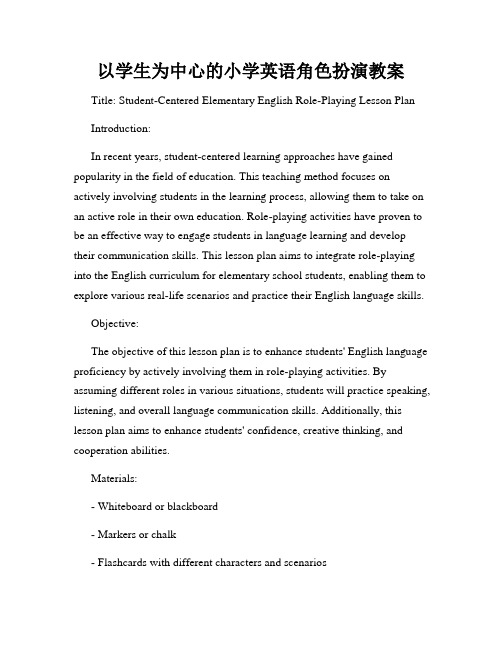
以学生为中心的小学英语角色扮演教案Title: Student-Centered Elementary English Role-Playing Lesson PlanIntroduction:In recent years, student-centered learning approaches have gained popularity in the field of education. This teaching method focuses on actively involving students in the learning process, allowing them to take on an active role in their own education. Role-playing activities have proven to be an effective way to engage students in language learning and develop their communication skills. This lesson plan aims to integrate role-playing into the English curriculum for elementary school students, enabling them to explore various real-life scenarios and practice their English language skills.Objective:The objective of this lesson plan is to enhance students' English language proficiency by actively involving them in role-playing activities. By assuming different roles in various situations, students will practice speaking, listening, and overall language communication skills. Additionally, this lesson plan aims to enhance students' confidence, creative thinking, and cooperation abilities.Materials:- Whiteboard or blackboard- Markers or chalk- Flashcards with different characters and scenarios- Small posters with role-playing prompts- Index cards with various dialogue prompts- A timerProcedure:Step 1: Warm-up activity (10 minutes)To engage students and prepare them for the role-playing activity, start with a warm-up activity. Divide the class into small groups and provide each group with flashcards featuring different characters. Each group should discuss and create a short description of their character's personality and background. Afterward, they will present their character to the whole class, using sentences like "My character's name is ___. He/She is ___ years old. He/She likes ___."Step 2: Introduction to role-playing (5 minutes)Explain the concept of role-playing to the students. Describe how it can be an effective tool for practicing English language skills by putting themselves in different scenarios. Emphasize that the purpose is to practice conversation, fluency, and language accuracy.Step 3: Role-playing activity (30 minutes)Divide the class into pairs or small groups and provide each group with a small poster containing a role-playing scenario. Allow them some time to discuss and plan their roles, actions, and dialogues. Then, invite each group to perform their role-play in front of the class. Encourage creativity and provide positive feedback to all participants.Step 4: Reflection and feedback (10 minutes)After each role-play performance, engage the class in a discussion about the scenarios and the use of English during the activity. Ask open-ended questions to encourage critical thinking and reflection. Provide constructive feedback and suggest improvements for future role-playing activities.Step 5: Extension activity (20 minutes)To further enhance language skills, distribute index cards with dialogue prompts related to the role-playing scenarios. Students should work individually or in pairs to have spontaneous conversations based on the provided prompts. Encourage them to utilize the vocabulary and grammar structures covered in the lesson.Step 6: Wrap-up and conclusion (5 minutes)Summarize the key points of the lesson and highlight the benefits of role-playing as a tool for language acquisition. Remind students of the importance of practicing and using English in real-life situations. Encourage them to continue exploring role-playing activities outside the classroom to further improve their language skills.Conclusion:Integrating role-playing activities into the elementary English curriculum creates an engaging and interactive learning environment for students. By assuming different roles in various scenarios, students can develop their English language skills, boost their confidence, enhance their creativity, and improve their cooperation abilities. This student-centered approachencourages active participation, allowing students to take ownership of their learning and fostering a positive attitude towards language acquisition.。
六上Unit3课时4Let'slearnRoleplay教案人教PEP
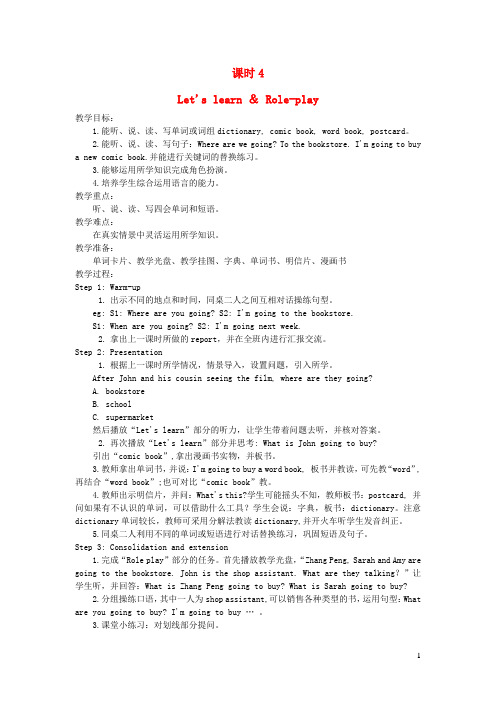
课时4Let's learn & Role-play教学目标:1.能听、说、读、写单词或词组dictionary, comic book, word book, postcard。
2.能听、说、读、写句子:Where are we going? To the bookstore. I'm going to buya new comic book.并能进行关键词的替换练习。
3.能够运用所学知识完成角色扮演。
4.培养学生综合运用语言的能力。
教学重点:听、说、读、写四会单词和短语。
教学难点:在真实情景中灵活运用所学知识。
教学准备:单词卡片、教学光盘、教学挂图、字典、单词书、明信片、漫画书教学过程:Step 1: Warm-up1.出示不同的地点和时间,同桌二人之间互相对话操练句型。
eg: S1: Where are you going? S2: I'm going to the bookstore.S1: When are you going? S2: I'm going next week.2.拿出上一课时所做的report,并在全班内进行汇报交流。
Step 2: Presentation1.根据上一课时所学情况,情景导入,设置问题,引入所学。
After John and his cousin seeing the film, where are they going?A. bookstoreB. schoolC. supermarket然后播放“Let's learn”部分的听力,让学生带着问题去听,并核对答案。
2.再次播放“Let's learn”部分并思考: What is John going to buy?引出“comic book”,拿出漫画书实物,并板书。
3.教师拿出单词书,并说:I'm going to buy a word book, 板书并教读,可先教“word”,再结合“word book”;也可对比“comic book”教。
人教PEP六年级上册英语《Unit2PartBLet'slearn-Role-play》教案
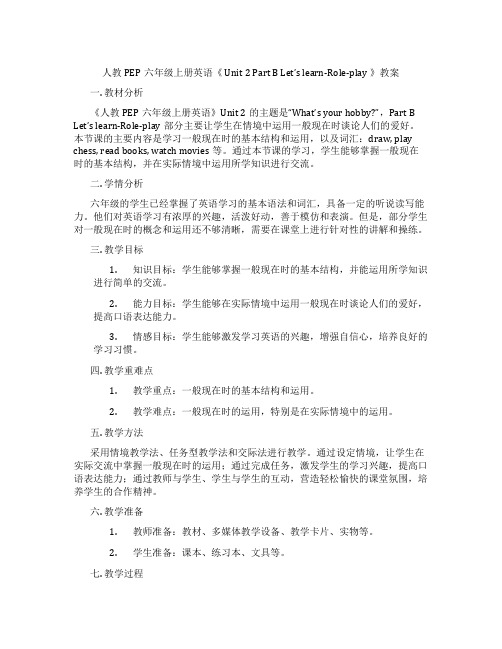
人教PEP六年级上册英语《Unit 2 Part B Let’s learn-Role-play 》教案一. 教材分析《人教PEP六年级上册英语》Unit 2的主题是“What’s your hobby?”,Part B Let’s learn-Role-play部分主要让学生在情境中运用一般现在时谈论人们的爱好。
本节课的主要内容是学习一般现在时的基本结构和运用,以及词汇:draw, play chess, read books, watch movies等。
通过本节课的学习,学生能够掌握一般现在时的基本结构,并在实际情境中运用所学知识进行交流。
二. 学情分析六年级的学生已经掌握了英语学习的基本语法和词汇,具备一定的听说读写能力。
他们对英语学习有浓厚的兴趣,活泼好动,善于模仿和表演。
但是,部分学生对一般现在时的概念和运用还不够清晰,需要在课堂上进行针对性的讲解和操练。
三. 教学目标1.知识目标:学生能够掌握一般现在时的基本结构,并能运用所学知识进行简单的交流。
2.能力目标:学生能够在实际情境中运用一般现在时谈论人们的爱好,提高口语表达能力。
3.情感目标:学生能够激发学习英语的兴趣,增强自信心,培养良好的学习习惯。
四. 教学重难点1.教学重点:一般现在时的基本结构和运用。
2.教学难点:一般现在时的运用,特别是在实际情境中的运用。
五. 教学方法采用情境教学法、任务型教学法和交际法进行教学。
通过设定情境,让学生在实际交流中掌握一般现在时的运用;通过完成任务,激发学生的学习兴趣,提高口语表达能力;通过教师与学生、学生与学生的互动,营造轻松愉快的课堂氛围,培养学生的合作精神。
六. 教学准备1.教师准备:教材、多媒体教学设备、教学卡片、实物等。
2.学生准备:课本、练习本、文具等。
七. 教学过程1.导入(5分钟)利用多媒体展示与本节课主题相关的图片,引导学生谈论人们的爱好。
例如,展示一张画有各种爱好的图片,让学生用中文说出图片中人物的爱好,然后翻译成英文。
人教版小学英语六年级上册Unit 3 My weekend plan第三课时教案

人教版小学英语六年级上册Unit 3 My weekend plan第三课时教案一、课时内容B let’s learn Role-play二、课时分析本课时是人教版六年级上册第三单元第三课时。
围绕“要够买的物品”这个话题展开,主要通过对话学习单词和词组dictionary, comic book, word book, postcard及句型Where are you going? I’m going to buy...的表达。
激发学生学习英语的热情,保持对英语学习的兴趣,树立学习英语的信心。
本课时的学习是为第四课时的学习做好铺垫。
本课时的重点是四会单词和词组的掌握以及能够运用四会单词和词组谈论和描述书店中自己要购买的物品。
本课时包括Let’s learn 和Role-play两个版块。
Let’s learn通过John和Jack在电影院前讨论下一步的计划的场景,呈现了单词及词组的词形和意义。
此话题与我们的学生的生活很密切,很能激起学生学习的兴趣。
Role-play版块是用于操练B Let’s learn版块中有关书籍的单词及词组。
通过学生在书店购书、买书的角色扮演,达到在真实的语境中交流的目的。
本课时的词汇中的词汇教学,要利用学生的迁移能力,结合学过的单词,用同类词归类或自然拼读法掌握。
句型的教学,不只是本课书上的知识,还要拓展句型,发散学生的思维。
在整个教学过程中,以激发学生学习兴趣为主,采用儿歌、游戏、猜谜、角色扮演等多种教学手段调动全体学生的参与,让学生在愉悦的环境下,自主的学习。
三、课时目标1. 能够听、说、读、写单词和词组:dictionary, comic book, word book, postcard2. 能够在情景中正确运用上述单词和词组讨论或描述自己书店中可以购买的物品。
3. 能够在情景中运用句型Where are you going? I’m going to buy...就购买计划进行询问和作答。
角色游戏教案模板英语小学
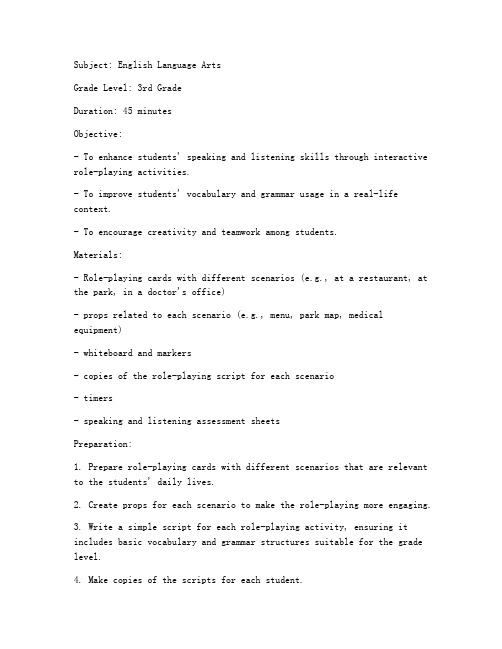
Subject: English Language ArtsGrade Level: 3rd GradeDuration: 45 minutesObjective:- To enhance students' speaking and listening skills through interactive role-playing activities.- To improve students' vocabulary and grammar usage in a real-life context.- To encourage creativity and teamwork among students.Materials:- Role-playing cards with different scenarios (e.g., at a restaurant, at the park, in a doctor's office)- props related to each scenario (e.g., menu, park map, medical equipment)- whiteboard and markers- copies of the role-playing script for each scenario- timers- speaking and listening assessment sheetsPreparation:1. Prepare role-playing cards with different scenarios that are relevant to the students' daily lives.2. Create props for each scenario to make the role-playing more engaging.3. Write a simple script for each role-playing activity, ensuring it includes basic vocabulary and grammar structures suitable for the grade level.4. Make copies of the scripts for each student.5. Set up the classroom with a designated area for role-playing.Lesson Procedures:1. Introduction (5 minutes)- Begin the lesson by introducing the concept of role-playing as a fun and interactive way to practice English.- Explain the purpose of the activity and the skills they will be developing.2. Vocabulary and Grammar Review (10 minutes)- On the whiteboard, review key vocabulary and grammar structures that will be used in the role-playing scenarios.- Use examples and simple exercises to reinforce the vocabulary and grammar points.3. Role-Playing Scenario Introduction (5 minutes)- Present one of the role-playing scenarios to the class.- Explain the context of the scenario and the roles that students will play.- Distribute the scripts and props to the students.4. Role-Playing Activity (20 minutes)- Divide the class into small groups, each group representing a different role in the scenario.- Set a timer for each role-playing session to ensure that all groups have an equal opportunity to participate.- Allow each group to practice their roles with the props and scripts.- Monitor the activity and provide assistance as needed.5. Reflection and Assessment (5 minutes)- After each role-playing session, bring the class back together to discuss the experience.- Ask students to share what they learned, what challenges they faced, and how they overcame them.- Distribute the speaking and listening assessment sheets to the students for self-evaluation.- Collect the scripts and props for future use.6. Wrap-up (5 minutes)- Summarize the key points of the lesson and the benefits of role-playing.- Encourage students to continue practicing their English in similar real-life contexts.Assessment:- Evaluate students based on their participation, pronunciation, vocabulary usage, and grammar accuracy during the role-playing activities.- Collect and review the speaking and listening assessment sheets to provide individual feedback.Extension Activities:- Have students create their own role-playing scenarios using the vocabulary and grammar structures learned in class.- Organize a school-wide role-playing fair where different classes present their scenarios to the rest of the school.Note: Adjust the complexity of the scenarios and the vocabulary/grammar structures according to the students' proficiency levels.。
- 1、下载文档前请自行甄别文档内容的完整性,平台不提供额外的编辑、内容补充、找答案等附加服务。
- 2、"仅部分预览"的文档,不可在线预览部分如存在完整性等问题,可反馈申请退款(可完整预览的文档不适用该条件!)。
- 3、如文档侵犯您的权益,请联系客服反馈,我们会尽快为您处理(人工客服工作时间:9:00-18:30)。
Lesson Plan
Topic __new words and phrases____________________ Date _____________________ No. of Students _______ Time: _____45minutes______________ CLASS PROFILE ______
GENERAL OBJECTIVES: students will be able to read and remember the words.
RATIONALE (i.e. why select these linguistic/conceptual objectives?)
LINGUISTIC: vocabulary plays an important role in English learning. Commanding a large number of words is vital for primary school students.
CONCEPTUAL/CULTURAL: the conversation is between primary school students, so it should be concise and simple.
ASSUMED KNOWLEDGE (i.e. what do you assume learners know/can do ?) LINGUISTIC: All students would be able to remember the vast majority of the words. And they could also make a conversation.
CONCEPTUAL/CULTURAL: All the students may have a clear understanding of the new words but they may not use them in a correct way.
AIDS Overhead projector, computer, lesson plan in PPT.
PROCEDURE
STAGE/TIMING TEACHER ACTIVITY STUDENT ACTIVITY WHY
Step 1
Warning–up activity to arouse students’
interest in this topic dividing students into group To make the conversation
smooth
playing the record for two to three times reading after the record to help impress
the students reading the words once again
Step 2
Correcting the students’ pronunciation to develop their
fluency of oral
English; to
know how to
put passive
words into
active use Step 3
Improving their fluency organizing the conversation and
Giving the presentation
Commenting on the students’ presentation
And giving advice to betterment to improve
their
language
skills
BLACKBOARD
ORGANISATION
Words with pictures Chinese meaning examples
FOLLOW UP/EXTENSION
1.invite one student to comment on other group’s performance. If possible, they can
perform what they have practiced.
2.
_ANTICIPATED PROBLEMS
POTENTIAL PROBLEM COUNTER-STRATEGY
(linguistic/ cultural/behavioral)
Cannot pronounce correctly
Being too shy and timid to perform encourage them to perform even for 40
seconds
CRITERIA FOR EV ALUATION
(i.e. how will you decide objectives have been met?)
1. the students are able to pronounce the words
2. the presentation goes on well
3. other students could say something about the presentation
4. _____________________________________________________________________________
ACTUAL EV ALUATION
(i.e. to what extent were objectives met/
what could you have done to improve effectiveness of lesson?)
1 The students can finish the performance successfully.
2 The students can remember a large part of the words.
Detailed Lesson Plan
Step 1
T: introduce the topic to the students and talk something interesting to arouse their
interest
S1: give his or her own thought about the tipoc
T: put on the MP3, ask students to read after it for several times
S2: try to read the words aloud and recite them
Step 2
T: according to the student’s command of the new words, ask students to perform
S3: give their performance
T: welcome other students to evaluate
Ss: give his or her comments
Step 3
T: point out the good aspect of the performance
S3: try to act under the guidance given by the teachers
T: put on a video and give special directions to the students
Ss:
Step 4
T : invite another group to perform
S students perform
T based on the former performances, try to make comparisons
S talk about anything related to what they have learned today
Ps.
Cognitive strategy: I categorize words according to parts of speech. Metacognitive strategy: I think that categorizing words according to parts of speech helps to memorize words.
Cognitive strategy: I pay special attention to topic sentences while reading.
Metacognitive strategy: I think that paying special attention to topic sentences while reading helps to get general idea of a text.。
